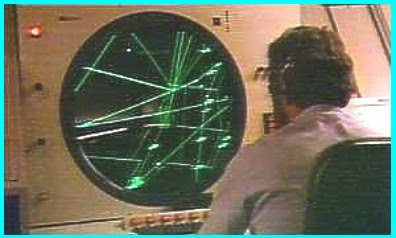
Reader Submitted Report
[Unedited]
2-27-08
Of course, the first year it was Boot Camp in Waukegan, Ill. but after that I was able to "strike for" for the navy discipline I most liked. I choose Radar.
I liked radar because I understood the basic principles of it and wanted to be "in the know" of everything that was going on just as did the ships officers and Captain. The Combat Information Center (CIC) was the place to be for that. I was pretty happy with that type of service. Besides, I did not have to swab the deck!
 The third year (summer of '57)) I was assigned training duty on the USS Columbus, a light cruiser, CA 74, departing out of Long Beach, CA.
The third year (summer of '57)) I was assigned training duty on the USS Columbus, a light cruiser, CA 74, departing out of Long Beach, CA. We departed for a two week cruise in the Pacific and one night off Catalina Island I was watching the radar scope to make sure we knew where all the surrounding ship traffic was.
It must have been about 7 or 8 p.m. just after dark when a hard contact blip showed up on my screen. It did not drift on the scope as such hard contacts do if you are passing or overtaking anther ship. It just "Popped" up on the screen.
I reported the contact bearing as the others watching a gang of redundant surface radar scopes did. The surface radar gives bearing and range of the blip contact. The range was about 20 miles from the ship. This is out of human sight since the horizon on the ocean is only 8 miles away and this blip was well beyond that.
After a minute or two, another blip appeared (popped on as the first one did) along side the first one, not very far away from it. These blips just materialized in an abnormal way but were "hard" contacts indicating something was definitely there. Well, certainly subs surfacing could account for this.
By this time the CIC officers were observing the scopes and taking pictures. Then these two blips were joined by three more contacts making 5 total. Guess what? They were in V formation! Well, this was an exciting event for everyone since five subs in V formation would be very unusual. We thought there may be a radar malfunction common to all the surface radars hooked up to the same horizontally rotating antennae. But then there was this: the blips were showing on a completely different and independent air defense radar system with the antennae operating up and down vertically to check altitude of contacts. These blips were at 5000 feet and hovering in one spot!
The officers were running around taking pictures of the scope presentations and showing some concern. After about 10 or 15 minutes, the five contacts began to disappear, one at a time. They disappeared instantly just as they had appeared instantly. Both surface and air radars showed them disappearing in the same instant until they were all gone. No one saw them visually since they were over the horizon, but both of the independent radar systems indicated they were there, in V formation.
Needless to say. That event was the talk of the ship for a while. All the radars were checked and found to be operating normally. In talking to some of the "Old Salts" I found out that they had similar experiences before on other ships. Wow. Non-the-less, the event was recorded officially as a "Radar Phenomenon" in the ship's logs. No one said "UFO", but believe me, they were. They were unidentified and they were flying.
Since then, I have had a keen interest in this type of phenomenon and I have heard of many UFO stories where the "contact popped up on the scope", appeared and disappeared very quickly on all manor of radar systems, curiously similar to my first hand experience. If one can sift through the reported "Kook" stuff, there is, in my view, something to all of this. I think more and more scientists, pilots and professional people would now attest to this and I see that you have said, "They are real!" (Fastwalkers)

Where's the ship's log ?
ReplyDeleteDoes anyone FOI "Radar Phenomenon" ?
Bet this isn't in BB ....
mike
I understand that an object 20 miles away cannot be seen due to the curvature of the earth. However, if an object is 20 miles away and at an altitude of 5,000 feet, it certainly should be visible to the human eye, much as we are able to see a 5,000 foot mountain that is 20 miles away.
ReplyDeleteGood Day MT!
ReplyDeleteThanks for your comment.
There are many factors involved with visibility, particularly over the ocean; for instance: light refraction, weather, size of the object etc.
Along those lines, in San Diego, residents can rarely see San Clemente Island, about 125 km offshore. The top of the island should just be visible above our horizon with normal refraction, but it's concealed by “airlight” during the day. Even in the clear air of a “Santa Ana,” which causes looming and raises more of the island above the apparent horizon, it's often hard to make out.
But just after sunset, the island is often visible, if you know where to look. The air between you and the island is only dimly illuminated after sunset, but the sky behind the island is still fairly bright. Then the silhouette of the island is striking, even if it had been invisible a few minutes before sunset.
By the same token, although one might see a "5,000 foot mountain" 20 miles away, they wouldn't be able to see a "marble at 5000 feet" at the same distance.
Cheers,
Frank
Hi Frank
ReplyDeleteAt an elevation of 5000 feet your horizon is over 86 miles away. Although refraction can alter this somewhat, for an object 20 miles away, these blips could not of been hidden by the horizon. In order for the object not to be optically detected from a Navy ship which has real good optics for this purpose the object would have to be really tiny which is inconsistent with the story about the hard blip appearing to be consistent with that made by an object the size a submarine.
Best Regards
Andrew